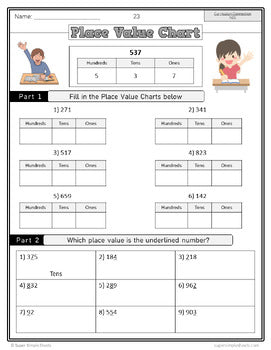Nova Scotia Grade 3 Math - Full Year Bundle
Nova Scotia Grade 3 Math - Full Year Bundle
Interested in a bundle? Shop below instead!
Couldn't load pickup availability
PRODUCT PREVIEW
BOTH DIGITAL AND PDF VERSIONS INCLUDED!
Nova Scotia 2022 Math Curriculum - Grade 3 – This resource covers all outcomes and indicators in the Grade 3 - Nova Scotia 2022 Math Curriculum.
There are 915 activity sheets for your students to learn and practice the outcomes and indicators in the curriculum. Using this resource will ensure that your students will be learning the Nova Scotia curriculum.
Distance Learning made easy! GOOGLE CLASSROOM VERSION - PDF INCLUDED! This gives you the ability to print worksheets as well as distribute a digital copy of the resource to your students on Google Classroom.
Check out each of the strands below to learn more about the resources included in this bundle.
Number Strand
Concepts that are covered:
- Counting by 1s through transitions
- Counting by 2s, 5s, 10s, and 100s to 1000
- Counting by 3s, 4s, and 25s
- Writing numbers to 1000
- Compose and decompose numbers to 1000
- Comparing and ordering numbers to 1000
- Estimate quantities using referents
- Determine place value of numbers to 1000
- Expanded form of numbers to 1000
- Mental math: addition strategies – doubling, adding in chunks, making 10
- Mental math: subtraction strategies – counting back, counting up, and subtracting in chunks
- Adding and subtracting numbers within 1000
- Basic addition and subtraction facts to 18
- Adding and subtracting word problems
- Estimating sums and differences
- Front-end estimation and rounding numbers
- When to estimate and when to use exact calculations
- Multiplication – repeated addition
- Multiplication strategies – skip counting, doubling and halving
- Multiplication visuals – arrays
- Multiplication and division of numbers up to 5 x 5
- Division strategies – repeated subtraction
- Division visuals – arrays
- Fair sharing and equal sharing
- Fractions – parts of a whole
- Representing situations using fractions
- Matching fractions
- Benchmark fractions
- Activities - Pizza fractions
- Comparing fractions
- Ordering fractions with like denominators
- 4 Unit Tests
- Answer pages for all activities
Patterns and Relations
Some of the concepts that are covered:
- Increasing patterns – geometric shapes
- Increasing patterns – blocks
- Increasing patterns found in real life
- Indigenous increasing patterns – beading
- Creating increasing patterns
- Translating increasing patterns into number sequences
- Decreasing patterns – shapes
- Translating decreasing patterns into number sequences
- Finding increasing and decreasing patterns on hundreds charts
- Finding the missing number in increasing and decreasing patterns
- Determining pattern rules
- Using a pattern rule to make a pattern
- Addition and subtraction number patterns
- Input/output tables
- Word problems involving addition and subtraction patterns
- Number strings – skip counting
- Introduction to T-Tables
- Ordinal numbers – describing a term in increasing and decreasing patterns
- Balancing equations – using different equations to equal the same sum/difference
- Balancing equations – using visuals
- Is the equation equal?
- Finding a matching equation
- Pre-algebra – finding the result unknown, change unknown, or start unknown
- Using symbols in algebraic equations
- Are the expressions equal?
- Word problems involving missing numbers
- Algebraic equations that match a real-life scenario
- 2 Unit Tests
- Answer pages for all activities
Measurement and Geometry
Some of the concepts that are covered:
- Non-standard units of time – seconds, minutes, hours, days, weeks, months, years
- How long does it take to do something using non-standard units
- Can you complete an activity in a minute, hour, day, week, month, or year?
- Days of the week
- Months of the year
- Months and years
- Converting time – minutes in an hour, hours in a day, days in a month, months in a year
- Reading a calendar
- Problem solving questions related to time
- Estimating measurements using referents – centimetres and metres
- Fingertip measuring
- Using a ruler to measure side lengths
- Finding perimeter of regular and irregular polygons
- Perimeter of composite shapes
- Constructing shapes for a given perimeter
- Drawing multiple shapes with the same perimeter
- When to use metres and when to use centimetres to measure
- Which object has more mass?
- Experiments - Measuring mass using a scale, measuring ice versus water
- Estimating the mass of objects
- Grams versus kilograms
- Vertices in polygons
- Number of sides in a polygon
- Regular versus irregular polygons
- Triangles, quadrilaterals, pentagons, hexagons, octagons
- Drawing shapes - triangles, quadrilaterals, pentagons, hexagons, octagons
- Finding shapes in our lives
- Naming angles in shapes – right angles, less than right, more than right
- Faces, edges, and vertices of 3D objects
- Naming 3D objects – spheres, cones, cylinders, pyramids, cubes, and prisms
- Finding shapes in 3D objects
- 4 Unit Tests
- Answer pages of all activities
Statistics and Probability
Some of the concepts that are covered:
- Sorting data
- Making lists
- Venn diagrams
- Tables/charts
- Carrol diagrams
- Writing questions for surveys
- Writing Yes/No survey questions
- Tally marks
- Organizing data using tally marks
- Collecting first-hand data
- Reading line plots
- Making line plots
- Why we use graphs
- Vertical and horizontal bar graphs
- Making a bar graph
- Scale of graphs
- Unit Test
- Answer pages for all activities
This is a comprehensive bundle that will save you hours of planning! It has been tested and found effective in helping students achieve the learning outcomes outlined in the Nova Scotia 2022 curriculum.
Answer pages for all slides/sheets are included!
Share













